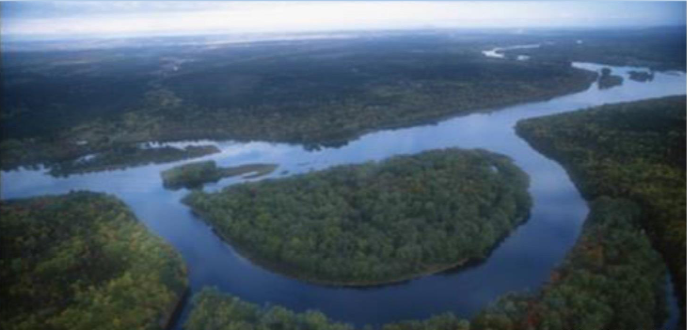The Penobscot River Basin has been home to Penobscot Indian Nation (PIN) and the Wabanaki Nations for over 9,500 years and is located in what is known today as the state of Maine. On the islands within the Penobscot River Basin, there are important PIN burial and ceremonial sites, as well as extensive floodplains and forested wetlands that have traditionally been used for cultural and subsistence activities by PIN Tribal citizens. Within the past 400 years and into the present day, resources of the river basin have been subject to colonial exploitation and industrial negligence resulting in habitat degradation and health hazards imposed on citizens of the Penobscot Indian Nation and their cultural traditions. To better understand the scale of this chemical contamination induced by industrial paper mills and settler colonialism, and the habitat degradation and health hazards that have been imposed on citizens of the Penobscot Indian Nation, The PIN and the Wabanaki Nations established partnerships with the EPA, and ASTDR resulting in four reports analyzed in this case study.
The four documents published were written based on scientific studies within the region to understand the impact of pollutants on the Penobscot River basin and provide consumption advisories for PIN Tribal Nation citizens harvesting traditional food sources amidst the anthropogenic impairment to their homelands. These documents have been used to provide data on the various ecological resources and traditional subsistence activities impacted by the toxic chemicals such as Mercury, PCDD/PCDFs, Industrial Waste, BOD (Biochemical Oxygen Demand)and PCBs (Polychlorinated biphenyls)released by mill effluents.
Each study, and its role in the technical process, has been included below to help inform the development of future health advisory guidelines for PIN Tribal Citizens and provide detailed reports on health and ecological impacts, history, restoration efforts, and present-day status of the Penobscot River basin. For further information on the history of the Penobscot River Basin, and the corporate negligence and federal inaction responsible for the health impacts to Tribal Citizens and their traditional homelands, a longer case study report has been developed to provide a more comprehensive history of pollutants of the region and can be found here:
•Penobscot River Health Contaminants: Case Study
| How Did They Do It? | Applicable Tribal-FERST Tools |
| Five federally recognized Tribal Nations in present day Maine coordinated with EPA to develop the Wabanaki Cultural Lifeways Exposure Scenario ‘Scenario’. -The scenario, published in 2009, resulted in a numerical representation of environmental contact, diet, and exposure pathways for Tribal Citizens using traditional cultural lifeways in Maine. -Funded by an EPA Direct Implementation Tribal Cooperative Agreement (DITCA) to the Aroostook Band of Micmac Indians on behalf of the five Tribal Nations in that region. -Allowed for the Maine Tribal Nations, to assess the levels of environmental contact, diet, and exposure pathways for Tribal Citizens using traditional cultural lifeways for contemporary applications such as the development of environmental standards and risk assessments. | |
| EPA R1 with EPA’s office of research and development was awarded an ORD grant, i.e regionally applied research effort to assess PIN Tribal Citizen exposure to contaminants from practicing sustenance lifeways. The research project was conducted in collaboration with Penobscot Indian Nation, United States Geological Survey (USGS), United States Fish and Wildlife Service (USFWS), ATSDR, and BIA. -The RARE Report, published in 2015, used traditional science, and specific cultural practices outlined in the Wabanaki Exposure Scenario to evaluate the environmental health of the riverine system, and conduct a preliminary screening of flora and fauna within the ecosystem. -The data was collected to determine the contaminant concentrations in fish, eel, snapping turtle, wood ducks, and plants in regions of the Penobscot River basin where PIN Tribal Citizens engage in subsistence activities, and whether they were high enough to be a health concern. -Assess potential exposures to mercury, dioxins, furans, and PCBs from ingestion of regional flora and fauna, and dermal contact of sediments in the absence of any remedial action within the study area. -Conducted as a preliminary study on multiple regions and species, not designed to be a statistically validated assessment of contamination differences between the regions and species assessed. | |
| The ATSDR, following a request from PIN, published the Public Health Assessment: Review of Sediment and biota Samples: Penobscot River, Penobscot Indian Nation, Maine. -This public health assessment, published in 2014, used data collected by EPA in 2008-2009 to evaluate samples of various fish species, as well as sediment, turtle, Wood duck, medicinal roots, and fiddlehead ferns to assess potential contaminants of concern detected in them. -This report determined that PIN Tribal Citizens who ate fish and turtle were the main people potentially exposed to Penobscot River contaminants, with mercury in these species found at levels that could cause a health hazard. Dioxins, furans, and dioxin link PCBs were also detected at levels that might pose an increased cancer risk. -The study resulted in ATSDR providing four conclusions for PIN Tribal Citizens to limit their exposure to these contaminants, and the health risks that accompany using traditional subsistence lifeways for these resources in the Penobscot River area. -This report was published following a prior health consultation published by ATSDR in 2006, which had analyzed fish sample data from 1988-2003 at the request of the Chief of the Penobscot Indian Nation in 2004. | |
| Using data from PIN DNR scientists and the documents above, the PIN Department of Natural Resources then published the Wild Foods: Safety Series brochure. -The brochure, published in a 2018 newsletter, detailed consumption advisories for Tribal Citizens using traditional subsistence lifeways in the area based on departmental data and the reports above. -This information, communicated directly from the PIN DNR, used their platform and established relationship with Tribal Citizens to properly communicate consumption levels, types of pollutants that these fish were contaminated with, and the health risks of ingesting those pollutants to keep PIN Tribal citizens safe when eating fish as a part of the PIN traditional subsistence diet. -This brochure was one of many published informative documents on the PIN DNR website which provides reports, publications, and educational links on toxic contaminants, non-point source pollution, pollution prevention, water quality/ watershed related issues, and human health information for PIN Tribal Citizens in the region. |



